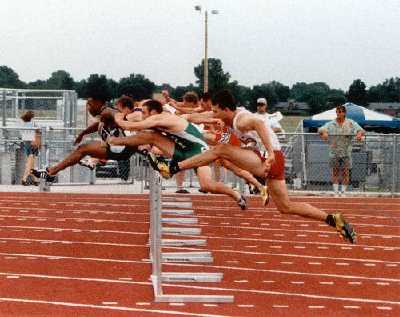 SKC Films Library SKC Films Library |
| SKC Films Library >> Recreation >> Track and Field Athletics >> Events |
| Hurdling a track and field race in which runners jump over fencelike obstacles called hurdles
Most races have 10 hurdles at equal intervals on the track. Both men and women run a 400-meter hurdle event in international competition. Men also run a 110-meter race, while women run a 100-meter event. The rules for all hurdle events are the same, but the hurdles themselves are different. Equipment All Olympic hurdle races include 10 hurdles. In the 110-meter, the hurdles measure 1.067 meters (3.5 feet) high. The first hurdle is set 13.72 meters (45 feet) from the starting line. There are 9.14 meters (30 feet) between hurdles, and 14.02 meters (46 feet) from the final hurdle to the finish line. In the 100-meter, the hurdles measure 0.84 meters (2.75 feet) high. The first hurdle is set 13 meters (~42.65 feet) from the starting line. There are 8.5 meters (~28 feet) between hurdles, and 10.5 meters (~34.5 feet) from the final hurdle to the finish line. In the 400-meter men’s race, the hurdles are 0.914 meters (3 feet) high. The first hurdle is set 45 meters (~147.6 feet) from the starting line. There are 35 meters (~115 feet) between hurdles, and 40 meters (~131 feet) from the final hurdle to the finish line. The hurdle setup in the 400-meter women’s race is the same as the men’s 400-meter except the hurdles are 0.762 meters (2.5 feet) high. Rules Each hurdler must stay in his or her own lane. Stepping into another runner's lane or jumping over a hurdle in another lane results in disqualification. Runners are not disqualified for knocking a hurdle over, unless it’s done intentionally. Hurdlers can be disqualified for failing to jump a hurdle or trailing a foot or leg below the horizontal plane of the top of any hurdle while clearing the hurdle. Whether a runner knocks down a hurdle intentionally or by lack of technique is decided by the event referee. Technique The ideal stride patterm for hurdling is 7 to 8 steps to the first hurdle, followed by 3 steps between each hurdle. 1) The runner leans toward the hurdle and drives the lead knee at the hurdle. The leading arm is also driven forward and up. 2 & 3) The runner leans toward the hurdle and lifts the lead foot to clear the hurdle while bending the trailing leg up and back. 4) As the lead leg clears the hurdle and begins coming down on the other side, the knee and foot of the trailing leg are pointed away from the body. 5 & 6) As the leading leg contacts the ground, the trailing leg is getting into position to begin the next sequence. Ideally, the hurdler will always lead with the same leg. History When and how hurdling initially developed is unknown. The 110-meter high-hurdle race was introduced to Olympic competition at the 1896 Athens Summer Games, and has been a regular event ever since. At first, the sport was performed by simply jumping over the hurdles. This changed with American Alvin Kraenzlein, who introduced a new striding technique for getting over the hurdles in 1900. This technique involved straightening the front leg while tucking the back leg underneath the body. After he won both the 110- and 200-meter hurdle events, Kraenzlein's technique became the standard for hurdling and is still used today. SOURCE |
| SKC Films Library >> Recreation >> Track and Field Athletics >> Events This page was last updated on June 24, 2017. |
